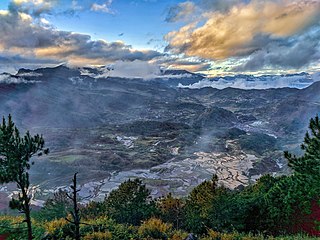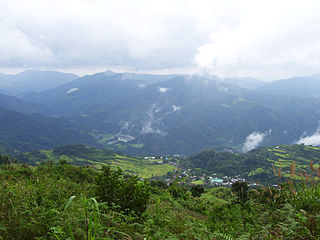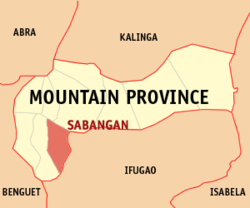
Mountain Province is a landlocked province of the Philippines in the Cordillera Administrative Region in Luzon. Its capital is Bontoc while Bauko is the largest municipality. Mountain Province was formerly referred to as Mountain in some foreign references. The name is usually shortened by locals to Mt. Province.

The Cordillera Administrative Region, also known as the Cordillera Region and Cordillera, is an administrative region in the Philippines, situated within the island of Luzon. It is the only landlocked region in the archipelago, bordered by the Ilocos Region to the west and southwest, and by the Cagayan Valley Region to the north, east, and southeast.

Bauko, officially the Municipality of Bauko is a municipality in the province of Mountain Province, Philippines. According to the 2020 census, it has a population of 32,021 people.

Boliney, officially the Municipality of Boliney, is a municipality in the province of Abra, Philippines. According to the 2020 census, it has a population of 4,551 people.

Tubo, officially the Municipality of Tubo, is a municipality in the province of Abra, Philippines. According to the 2020 census, it has a population of 5,674 people.

Barlig, officially the Municipality of Barlig is a municipality in the province of Mountain Province, Philippines. According to the 2020 census, it has a population of 4,796 people, making it the least populated town in the province.

Besao, officially the Municipality of Besao is a municipality in the province of Mountain Province, Philippines. According to the 2020 census, it has a population of 6,873 people..

Bontoc, officially the Municipality of Bontoc, is a municipality and capital of the province of Mountain Province, Philippines. According to the 2020 census, it has a population of 24,104 people.

Natonin, officially the Municipality of Natonin, is a municipality in the province of Mountain Province, Philippines. According to the 2020 census, it has a population of 10,339 people.

Sadanga, officially the Municipality of Sadanga is a municipality in the province of Mountain Province, Philippines. According to the 2020 census, it has a population of 8,427 people.

Sagada, officially the Municipality of Sagada is a municipality in the province of Mountain Province, Philippines. According to the 2020 census, it has a population of 11,510 people.

Tadian, officially the Municipality of Tadian is a municipality in the province of Mountain Province, Philippines. According to the 2020 census, it has a population of 19,341 people.

Balbalan, officially the Municipality of Balbalan, is a municipality in the province of Kalinga, Philippines. According to the 2020 census, it has a population of 12,914 people.

Lubuagan, officially the Municipality of Lubuagan is a municipality in the province of Kalinga, Philippines. According to the 2020 census, it has a population of 9,323 people.

Pasil, officially the Municipality of Pasil, is a municipality in the southwestern part of the Kalinga. It is bounded on the north by the municipality of Balbalan, on the south by the municipality of Tinglayan, on the east by Tabuk city, and on the west by the province of Abra and south-western part of the municipality of Sadanga, Mountain Province. According to the 2020 census, it has a population of 10,577 people.

Rizal, officially the Municipality of Rizal is a municipality in the province of Kalinga, Philippines. According to the 2020 census, it has a population of 19,554 people.

Tabuk, officially the City of Tabuk, is a 5th class component city and capital of the province of Kalinga, Philippines. According to the 2020 census, it has a population of 121,033 people making it the most populous in the province.

Tanudan, officially the Municipality of Tanudan, is a municipality in the province of Kalinga, Philippines. According to the 2020 census, it has a population of 8,746 people, making it the least populated municipality in the province.

Hungduan, officially the Municipality of Hungduan is a municipality in the province of Ifugao, Philippines. According to the 2020 census, it has a population of 8,866 people, making it the least populated municipality in the province.
The Chico River Dam Project was a proposed hydroelectric power generation project involving the Chico River on the island of Luzon in the Philippines that locals, notably the Kalinga people, resisted because of its threat to their residences, livelihood, and culture. The project was shelved in the 1980s after public outrage in the wake of the murder of opposition leader Macli-ing Dulag. It is now considered a landmark case study concerning ancestral domain issues in the Philippines.
























